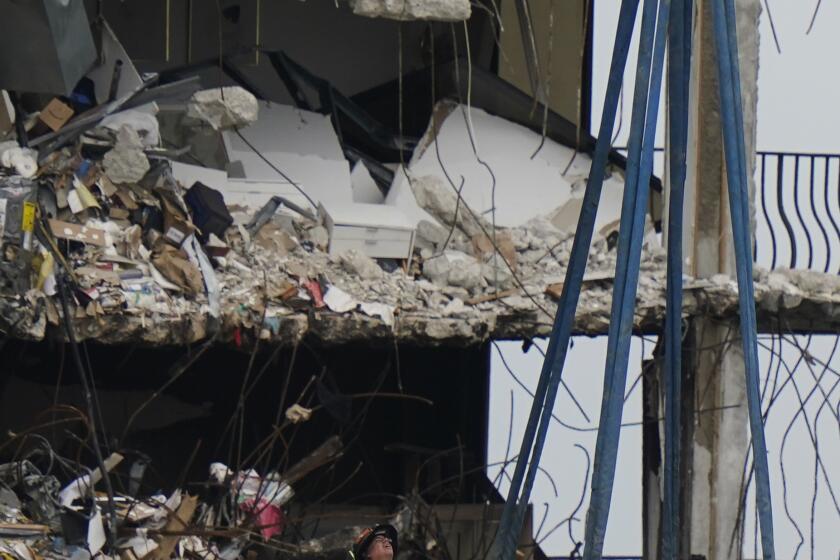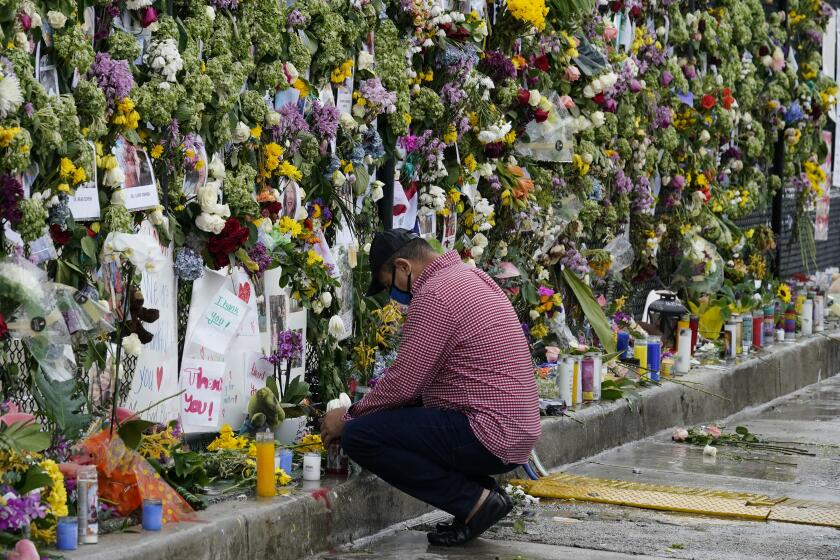Lawsuits seeking answers, and blame, for Florida condo collapse have already begun

- Share via
As the search continues for signs of life in the debris of the fallen Champlain Towers South, the process of trying to determine why it happened and who is to blame is already underway in Florida’s legal system.
Authorities have opened criminal and civil investigations into the June 24 partial collapse of the oceanfront condo building, which left at least 32 confirmed dead and more than 113 unaccounted for. Miami-Dade State Atty. Katherine Fernandez Rundle pledged to bring the matter soon before a grand jury, which could recommend criminal charges or simply investigate the cause to suggest reforms.
And at least five lawsuits have been filed on behalf of residents who survived or are feared dead. One lawyer involved in the litigation said the collapse raised widespread concern about infrastructure issues and the trust we put in those responsible for them.
“We deserve to be able to walk into buildings without worrying that they’re going to come crumbling around us and to know that our loved ones can go to bed at night without worrying that they’re going to plummet 12 stories to the ground below in their sleep,” said Jeffrey Goodman, whose Philadelphia-based firm filed suit on behalf of the children of missing resident Harold Rosenberg.
The lawsuits filed to date accuse the Champlain Towers South Condominium Assn., and in some cases a local architect and engineer, of negligence for failing to address serious structural problems noted as far back as 2018. A Surfside town building inspector had also been part of the discussions, and Goodman’s firm has given notice of plans to add the town as a defendant.
“The role of building owners and architects and engineers and inspectors and safety professionals is to make sure that buildings are safe for their occupants to be in,” Goodman said.
A former city official who assured leaders that a Miami-area condo building was in ‘very good shape’ three years before it collapsed has left his new job.
At a hearing Friday, a judge appointed a receiver to represent the condominium association’s interests given the trauma experienced by board members, one of whom remains missing. The board has about $48 million in insurance coverage, while the oceanfront land is valued at $30 million to $50 million, the judge was told.
The judge said he hoped the litigation could be resolved quickly, perhaps within a year. Until then, he authorized the receiver, attorney Michael Goldberg, to provide $10,000 each to residents for temporary housing and $2,000 to cover funeral expenses.
Attorney Robert Mongeluzzi, who also represents the Rosenberg family and is seeking access to the site, said cases such as these are not just about the money.
“They want to make this a quest to find out what happened,” Mongeluzzi said. “We believe that evidence is still there.”
A week after the condo collapsed, 24 bodies have been recovered. Pablo Rodriguez’s mother and his grandmother are still missing.
Attorneys for the condominium association did not respond to emails seeking comment, nor did board members themselves.
One prior case with possible legal parallels involves the 2013 collapse in Philadelphia of an unbraced wall of a building that was being demolished. It toppled onto an adjacent Salvation Army store, killing six people and injuring 13. One woman found alive 13 hours after the collapse lost both her legs and endured more than 30 surgeries before her death this year.
In the trials that followed, a civil jury found the Salvation Army, the building’s owner and his architect largely responsible, and the parties agreed to pay $227 million in damages.
On the criminal side, the architect received immunity in exchange for cooperating with prosecutors, while a food cart operator-turned-contractor was acquitted of third-degree felony murder charges but sentenced to 15 to 30 years in prison for involuntary manslaughter. A forklift driver who was taking prescription drugs for an injury also went to prison.
A memorial in Surfside, Fla., has become a place to pay tribute to those who lived in the condominium that, without warning, fell in the middle of the night.
The collapse prompted the city of Philadelphia to send inspectors to examine demolition sites and led to toughened regulations.
In Florida, a grand jury is still reviewing the 2018 collapse of a pedestrian bridge at Florida International University that killed six people. And both manslaughter and third-degree felony murder charges were filed following the 1996 accidental crash of ValuJet 592 in the Everglades, which killed 110 people.
Denis Bender, a tort law professor at Chapman University who studies large-scale disasters, sees a growing tendency in such cases not just to seek damages but to pursue criminal charges, often for negligence. That may be because, more and more, we see them happen in real or near-real time, as happened with the harrowing images beamed from Surfside around the world in the last week.
“I think it’s increasing because of the media and social media — not necessarily because there’s a drumbeat out there, but everybody’s horrified by what they can see. And there’s this cry for justice,” Binder said.
“On something spectacular like this, in today’s world, there’s great pressure to find fault,” he said. “And there’s enough evidence already [in Surfside] that people have made bad decisions.”
More to Read
Sign up for Essential California
The most important California stories and recommendations in your inbox every morning.
You may occasionally receive promotional content from the Los Angeles Times.















